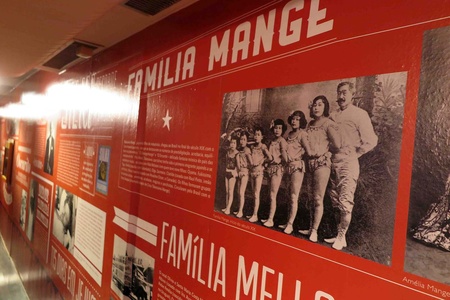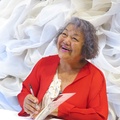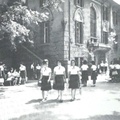Performing in Sao Paulo in May 1873?
They performed in Uruguay in January and February of the year 1873 (Meiji 6), and at the then Colón Theatre in Buenos Aires in Argentina in the following March as well. Unfortunately, I haven’t been able to find anything on the Brazilian National (Digital) Library site no matter how many times I search by the word “Satsuma.”
However, when I searched by “japonesa,” I came across the paper Correio Paulistano dated May 10, 1873. When I opened it, I found an ad which mentioned Japanese acrobats on page 4.
“First-time performance using a big ladder, A Escada Japoneza the extremely challenging Japanese-style ladder acrobatics (by the performer Jeronymo and Joannito the lad getting a big round of applause).”
This was part of the performance of Pereira Brothers Circus Troupe which was held in Largo São Bento in the city of São Paulo at 8 p.m. on Saturday, May 10, 1873. Surprisingly, they seemed to be the first Japanese to perform acrobatics in São Bento in the Centro district of São Paulo City, 35 years prior to the arrival of Kasato-maru. This fact will dramatically change the history of the Japan-Brazil relation.
Japanese acrobats had a performance in São Paulo City in May of the same year as the Uruguay and Argentine performances. This means that for some reason some members of Satsuma Company might have performed in Brazil.
What suddenly came to mind was the following note on page 20 of the History of Japanese Immigrants in Argentina—Part 1.
“What happened to Satsuma Company afterwards? President of Diario Japones en la Argentina Takeshi Ehara (who was also a writer) wrote a piece titled ‘The Mystery of La Japonesa Village.’ He expressed that ‘some people say this company disbanded in Buenos Aires, and we can assume that a performer named Ohinata, who later joined the company that Pepe Podestá belonged to, was definitely one of the former members of Satsuma Company.’”
The theory suggests that Satsuma Company disbanded in Buenos Aires, and some former members ended up in São Paulo City and performed on May 10. In fact, if this were not the case, they wouldn’t have been able to have a performance in São Paulo at that time.
If Satsuma Company did disband in Buenos Aires, that would explain why there was no advertisement under their name in any newspapers in Brazil back then. They probably worked individually, and some came to São Paulo. If this were the case, then we could connect the dots.
Manji (Mange) Takezawa: the legendary figure in the immigration history of Brazil
Without doubt, the very first Japanese acrobat to appear in the history of Brazil is Manji Takezawa. It’s said that he “led a circus troupe himself around 1870 and toured from Rio de Janeiro to Amazonas and to the southernmost Rio Grande do Sul state, and further south to Uruguay and to Argentina as well.”

In other words, he was one of the legendary figures who moved overseas and made a living on their own during the “sacred period,” before the official start of Japanese immigration.
Two years before Kasato-maru set sail, Saburosuke Fujisaki opened the first Japanese-owned retail store on São Bento Street in São Paulo City in 1906. Soon after, Manji Takezawa was feeling nostalgic and visited a fellow from Japan for the first time since he moved to Brazil.
However, what he spoke at the time is said to be something that sounded more like broken Japanese, as Manji Takezawa had not used Japanese for over two decades: “Is Emperor still safe and sound?” Upon hearing it, Nanju Suzuki for the first time noted on the anecdote which was to be passed on for many generations to come—“Manji is indeed a samurai soldier and surely Japanese.”
It is possible that this Manji Takezawa and the boy in his company could have been the “performer Jeronymo and Joannito the lad” in the ad. In other words, Manji Takezawa and his fellows were former members of Satsuma Company, and they headed to São Paulo, Brazil, after the troupe disbanded in Buenos Aires.
As a side note: in the late Edo period, there was a famous top spinning performer in Japan by the name of Manji Takezawa with a different kanji. Whether or not the two were the same person is another big mystery.
I’ve published a series with 27 articles about Manji Takezawa in Nikkey Shimbun titled “Uncovering the mystery of acrobat Manji Takezawa = the history of interaction between Japan and Brazil in circus business” in February 2016. I would very much appreciate it if you could take a look.
One of the keys to solve the mystery of who had come to São Paulo is the “Japanese-style ladder acrobatics.” What kind of performance was it?
One possibility is that an adult performer would have a child stand on his/her legs and the child would keep piling boxes at his/her feet to climb higher and higher.
This in fact is exactly the kind of performance that Manji Takezawa would have been good at. “Jeronymo” really might have been his stage name for the first performance in Brazil. However, there is no solid proof of this.
Still, we can say that a Japanese acrobat had a performance at the São Bento venue near the current Toyo district in São Paulo City as early as in 1873 (Meiji 6).
Coincidentally, it was the year in which Yukichi Fukuzawa in Viewing of Country Names introduced the country name “Brazil” to Japanese people for the first time in a geography book.
Even Yukichi Fukuzawa at the time probably could not have even imagined that a group of Japanese had already landed on South America by then and had an acrobatic performance there.
© 2022 Masayuki Fukasawa






